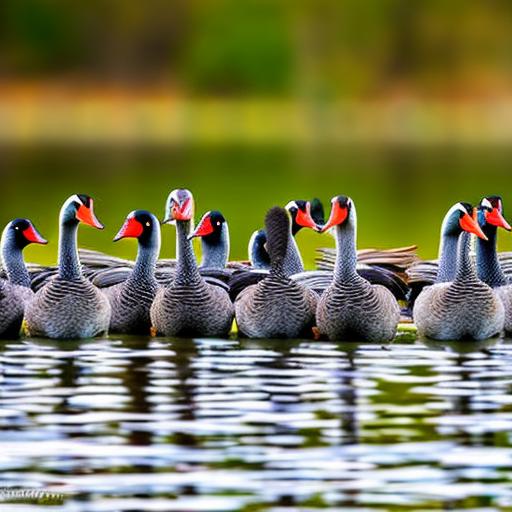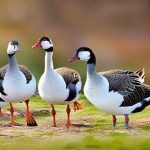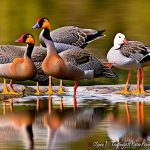Geese are known for their strong migratory instincts and their tendency to form strong family bonds. They are highly social birds and often travel in large flocks. Geese are also known for their territorial behavior, especially during the breeding season. They are protective of their nesting sites and can become aggressive if they feel threatened. Understanding these behaviors is crucial when it comes to managing and deterring geese from unwanted areas.
Geese are also attracted to areas with abundant food sources, open water, and suitable nesting sites. They are herbivores and feed on grasses, grains, and aquatic plants. This means that areas with lush greenery and water bodies are particularly attractive to geese. By understanding these behaviors, property owners can take proactive measures to deter geese from settling in these areas. It is important to note that geese are protected under wildlife regulations, so it is essential to use humane and non-lethal methods to manage their presence.
Key Takeaways
- Geese are territorial and protective of their nesting areas, so understanding their behavior is crucial in deterring them.
- Physical deterrents such as fences, barriers, and repellent sprays can effectively discourage geese from settling in an area.
- Visual and audio deterrents like scarecrows, predator decoys, and sound machines can help in keeping geese away from properties.
- Natural repellents such as grape seed extract and garlic-based sprays can be used to repel geese without harming the environment.
- Keeping the environment clean by removing food sources and maintaining landscaping can make an area less attractive to geese.
- Seeking professional assistance from wildlife experts can provide effective and humane solutions for managing geese.
- It is important to respect wildlife regulations and seek proper permits before implementing any deterrent methods for geese.
Implementing Physical Deterrents
Physical deterrents are one of the most effective ways to deter geese from unwanted areas. These deterrents include barriers such as fences, hedges, and netting to prevent geese from accessing certain areas. Another physical deterrent is the use of tactile repellents such as spikes or wires on surfaces where geese tend to roost or nest. These deterrents make it uncomfortable for geese to land or walk on these surfaces, discouraging them from staying in the area.
Another physical deterrent that can be effective is the use of motion-activated sprinkler systems. These systems release a burst of water when they detect movement, startling and discouraging geese from staying in the area. Additionally, using trained dogs to patrol the area can also be an effective physical deterrent. The presence of a predator such as a dog can make geese feel threatened and encourage them to find a safer location.
Using Visual and Audio Deterrents
Visual and audio deterrents can also be effective in deterring geese from unwanted areas. Visual deterrents include the use of decoys such as fake predators or replicas of natural predators like coyotes or owls. These decoys can create the illusion of danger and make geese feel unsafe, prompting them to leave the area. Another visual deterrent is the use of reflective objects such as tape or balloons to create a disorienting environment for geese.
Audio deterrents involve the use of sound devices that emit distress calls of geese or other bird species, as well as predator calls or loud noises. These sounds can create a sense of danger and prompt geese to seek safety elsewhere. It is important to regularly change the location and pattern of these deterrents to prevent geese from becoming accustomed to them.
Employing Natural Repellents
Natural repellents can also be used to deter geese from unwanted areas. These repellents include the use of natural odors and tastes that are unpleasant to geese. For example, the application of grape seed extract or methyl anthranilate on grass and vegetation can make it unappealing for geese to feed on. Additionally, the use of garlic or chili pepper-based sprays can create an unpleasant odor and taste for geese, discouraging them from staying in the area.
Another natural repellent is the use of landscape modifications such as planting tall grasses or shrubs that create barriers and make it difficult for geese to access certain areas. These natural barriers can discourage geese from settling in these locations and encourage them to find alternative habitats.
Maintaining a Clean and Unattractive Environment
One of the most important steps in deterring geese from unwanted areas is to maintain a clean and unattractive environment. Geese are attracted to areas with abundant food sources, open water, and suitable nesting sites. By removing or minimizing these attractions, property owners can discourage geese from settling in these areas. This can be achieved by regularly mowing grassy areas to reduce the availability of food, removing standing water sources, and implementing landscaping practices that make it difficult for geese to access suitable nesting sites.
It is also important to properly dispose of food waste and avoid feeding wildlife in these areas, as this can attract geese and other wildlife species. By maintaining a clean and unattractive environment, property owners can significantly reduce the likelihood of geese settling in these locations.
Seeking Professional Assistance

In some cases, managing geese populations may require professional assistance. Wildlife management companies and professionals have the expertise and experience to assess the situation and implement effective deterrence strategies. These professionals can conduct site assessments, develop customized management plans, and implement a combination of deterrent methods to effectively manage geese populations.
Additionally, seeking professional assistance ensures that property owners comply with wildlife regulations and use humane and non-lethal methods to manage geese populations. Professional wildlife management companies also have access to specialized equipment and resources that can enhance the effectiveness of deterrence strategies.
Respecting Wildlife Regulations
It is crucial for property owners to respect wildlife regulations when managing geese populations. Geese are protected under wildlife regulations, and it is illegal to harm or kill them without proper permits or authorization. Property owners must use humane and non-lethal methods to manage geese populations, ensuring that these methods do not cause harm or distress to the birds.
Additionally, property owners should be aware of any local or state regulations regarding the management of wildlife populations, including geese. It is important to consult with wildlife authorities or professionals to ensure that deterrence strategies comply with these regulations.
In conclusion, deterring geese from unwanted areas requires a comprehensive understanding of their behavior and the implementation of effective deterrence strategies. By using a combination of physical, visual, audio, and natural deterrents, maintaining a clean environment, seeking professional assistance when necessary, and respecting wildlife regulations, property owners can effectively manage geese populations while ensuring the safety and well-being of these protected birds.
If you’re looking for effective ways to keep geese off your boat dock, you may also be interested in learning about creating a secure and comfortable space for your chickens. Check out this insightful article on garden chicken coop designs, which offers valuable tips on providing a safe and enjoyable environment for your feathered friends. Just as you want to protect your boat dock from geese, it’s important to ensure that your chickens have a cozy and predator-proof coop.
Meet Walter, the feathered-friend fanatic of Florida! Nestled in the sunshine state, Walter struts through life with his feathered companions, clucking his way to happiness. With a coop that’s fancier than a five-star hotel, he’s the Don Juan of the chicken world. When he’s not teaching his hens to do the cha-cha, you’ll find him in a heated debate with his prized rooster, Sir Clucks-a-Lot. Walter’s poultry passion is no yolk; he’s the sunny-side-up guy you never knew you needed in your flock of friends!







